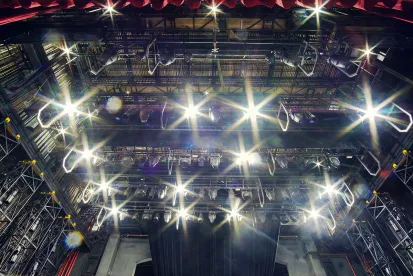The US Court of Appeals for the Second Circuit partially affirmed a district court’s summary judgment order holding that audiovisual recordings of live concerts do not fall within the scope of the Copyright Act’s compulsory license provision while purchasers of audio-only recordings obtain a compulsory license in the copyright of the work fixed by their predecessors/sellers. ABKCO Music, Inc. et al. v. Sagan et al., Case No. 20-3816 (2d Cir. Oct. 6, 2022) (Jacobs, Wesley, Menashi, JJ.)
In 2002, William Sagan purchased, through Norton, a collection of audio and audiovisual live concert recordings from Bill Graham Archives. All three parties are named defendants in this case. The agreement conveyed all intellectual property that the Archives held (from a transaction with Sagan) and included a disclaimer stating that record company and artist approval was required to exploit the recordings. The defendants’ subsequent purchases of other recordings contained similar limited assurance language regarding intellectual property rights. In 2006, the defendants made the entire collection publicly available online for a streaming and downloading fee. A year later, the defendants began using a third-party licensing agent to obtain compulsory licenses under 17 USC § 115 and negotiated licenses from plaintiff music publishers in the audio and audiovisual live concert recordings.
Section 115 of the Copyright Act requires persons seeking to make and distribute phonorecords of a previously published musical work to obtain a compulsory license by providing notice to the copyright owner before distribution and paying government-prescribed royalties. (§ 115(a)(1), (b), (c).) The Copyright Act defines phonorecords as “[m]aterial objects in which sounds, other than those accompanying a motion picture or other audiovisual work, are fixed.” (§ 101.) Section 115’s substantive requirements for duplications of audio/sound recordings fixed by another include requirements that the sound be fixed lawfully, and that duplication be authorized by the copyright owner. (§ 115(a)(1).)
In 2015, the music publishers sued defendants for copyright infringement of 197 musical works posted online without valid compulsory licenses. The music publishers alleged that the defendants did not obtain compulsory licenses for audiovisual works as required by § 115 and that the defendants failed to comply with § 115 substantive compulsory licensing requirements for audio-only works. Defendants argued implied license and equitable estoppel as affirmative defenses. The publishers sought damages and a permanent injunction pursuant to the Copyright Act.
The district court, on summary judgment, ruled that the defendants had no valid license authorizing the reproduction and distribution of the musical works in either audio or audiovisual format, that the defendants had neither an implied license nor any basis for estoppel, and that Sagan (a principal in several of the defendant streaming services) was liable for direct infringement. The district court denied the publishers’ request for an injunction but granted the publishers an award of attorneys’ fees. The defendants appealed from the summary judgment order and the order granting fees and costs. The plaintiffs cross-appealed denial of an injunction.
The Second Circuit affirmed the district court’s holding that the defendants infringed each musical work included in an audiovisual recording because the Copyright Act’s definition of “phonorecords” excluded all audiovisual recordings (including recordings of live concerts). The Court rejected the defendants’ contention that one thing can only “accompany” another (within the meaning of the exclusion) if it is otherwise separate, such as a soundtrack in which the sound is layered over a motion picture, but not a recording of a live performance in which the sound and image are fixed simultaneously. The Court reasoned that “given the common and natural meaning of the word, sound can ‘accompany’ an image simultaneously as well as by later addition.”
The Second Circuit reversed the district court’s holding that the defendants infringed the audio-only recordings because they did not obtain authorization by the copyright owner under § 115’s substantive requirements for duplications of audio/sound recordings fixed by another. The Court explained that because the defendants’ predecessors/sellers fixed and owned the audio-only recordings, and since the defendants acquired all rights the predecessors/sellers held through purchase, the recordings were not “fixed by another.” The Court also vacated the district court’s $2.4 million award of attorneys’ fees because it was based in part on this erroneous ruling.
The Second Circuit affirmed the district court’s denial of the defendant’s implied license and equitable estoppel defenses. The Court rejected the defendants’ argument that plaintiffs’ acceptance of royalty payments constituted consent to use the recordings because royalty payments (unlike compulsory licenses) do not put copyright owners on notice regarding how a license will be used, and knowledge is a key element to the affirmative defenses.
The Second Circuit also affirmed the district court’s denial of the publishers’ request for permanent injunction, explaining that the public has an interest in accessing the collection of iconic musical recordings and that denying a permanent injunction of old concert recordings would not curb creativity.
Lastly, the Second Circuit reversed the district court’s finding that Sagan (a principal in two of the defendant streaming services) was directly liable for copyright infringement. It was undisputed that Sagan had a direct financial interest and supervision power over the copyright infringement. The Court agreed that under its 2016 ruling in EMI Christian Music Grp., “[e]ven if a copyright is not infringed by a corporate officer’s own hand, a corporate officer with an obvious and direct financial interest, and a power of supervision to effect an infringement, may be vicariously liable.” Here, however, the publisher only pled direct liability. Under the Second Circuit’s 2008 ruling in Cartoon Network, direct liability may attach for “volitional conduct,” but only to “the person who actually presses the button.” Therefore, although it was undisputed that Sagan instructed which concerts to make available for download and that he could be held vicariously liable on a different pleading, he was not a direct infringer.
Kavya Rallabhandi authored this article.



 />i
/>i
